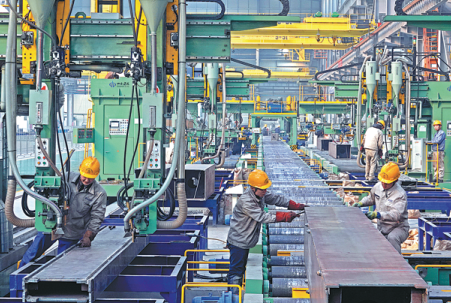Building technique delivers remarkable efficiency
Updated: 2021-06-25

Building members are produced at a plant of Shanxi Construction Investment Group. [Photo by Liu Tong for China Daily]
A conventional mason would be astonished at the modern efficiency of house building upon paying a visit to a civil engineering company in the city of Yuncheng in the south of Shanxi.
The solution offered by the company, Yuncheng Construction Engineering Group, is a revolutionary one: houses are not built but assembled.
Building members are manufactured at the YCEG plant and delivered to construction sites for assembly. The construction process can be several times faster than conventional ways.
Li Xiaodong, a manager for research and development at the company, said buildings constructed this way are called assembled structures.
"Compared with conventional ways of construction, assembled structures, especially the steel structures, have unrivaled advantages," Li said. "The new way of construction features greater efficiency, saves labor and resources and promotes better safety."
Haozhao Southeast Green Construction is another provider of assembled structures in Yuncheng.
In the two years since its establishment, it has been commissioned to assemble key structures at the 2022 Winter Olympics venues in Beijing and Zhangjiakou in Hebei province, as well as the No 3 terminal of Yuncheng Airport.
Assembled structures represent a new direction in the civil engineering sector, industry insiders said.
In Shanxi, about 18.7 percent of the buildings, or 8.23 million square meters in floor space, were constructed with the assembly techniques in 2020, according to the Shanxi Department of Housing and Urban-Rural Development.
The ratio was even higher in the provincial capital of Taiyuan, with 3.3 million sq m, or 25.48 percent of new buildings being assembled structures.
The department predicts the ratio of assembled structures in Shanxi will reach 30 percent in 2025.
Lai Zhongyi, chief engineer at the Taiyuan-based Shanxi Institute of Architectural Design and Research, said the new way of construction also has many environmental benefits.
"As building members are manufactured in plants with automated production facilities, the use of raw materials and other resources can be minimized," Lai said. "And the assembly process at construction sites substantially reduces the use of sand, bricks and concrete, leading to a decrease in solid wastes."
Lai estimated the assembled structures can lead to a reduction of 70 percent in solid waste, and also save timber, cement and water by 60 percent, 55 percent and 25 percent, respectively.
"More importantly, many of the building members can be recycled after the life circle of a building expires," Lai said. "Disposal of the solid waste after tearing down outdated buildings is a big challenge that the civil engineering sector must face in the future. And assembled structures can offer a solution to this challenge."
The assembled structures industry has also become increasingly driven by high tech.
One example is Xiaohe Construction Industry, based in the Shanxi Transformation and Comprehensive Reform Demonstration Zone.
The company is using numeric-controlled technologies and robots in its manufacturing process.
"With these cutting-edge technologies and devices in place, we are capable of producing superlarge steel structural members with a length of 16 meters and width of 4.5 meters," said Feng Jingbang, an engineer at the company.
According to the Shanxi Department of Housing and Urban-Rural Development, there are 18 enterprises in the province engaged in the manufacturing of building members for assembled structures. Their combined production capacity recently reached 18.7 million sq m a year, which can meet the demands not only in Shanxi but also other regions in the country.
Wang Pei contributed to this story.



